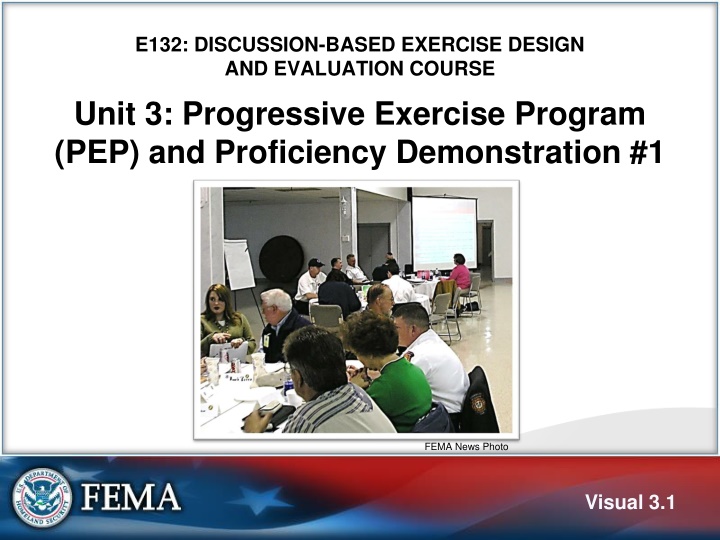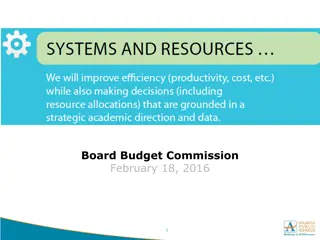
Emergency Management Training and Exercise Program Overview
Explore the objectives of a Progressive Exercise Program (PEP) focusing on emergency management policy, whole community approach, and exercise planning. Understand the importance of exercises in revealing weaknesses, improving coordination, and meeting regulatory standards. Learn how an exercise can better prepare communities for disasters and the significance of the whole community approach in national preparedness.
Download Presentation

Please find below an Image/Link to download the presentation.
The content on the website is provided AS IS for your information and personal use only. It may not be sold, licensed, or shared on other websites without obtaining consent from the author. If you encounter any issues during the download, it is possible that the publisher has removed the file from their server.
You are allowed to download the files provided on this website for personal or commercial use, subject to the condition that they are used lawfully. All files are the property of their respective owners.
The content on the website is provided AS IS for your information and personal use only. It may not be sold, licensed, or shared on other websites without obtaining consent from the author.
E N D
Presentation Transcript
E132: DISCUSSION-BASED EXERCISE DESIGN AND EVALUATION COURSE Unit 3: Progressive Exercise Program (PEP) and Proficiency Demonstration #1 FEMA News Photo Visual 3.1
Unit Objectives By the end of this unit you will be able to: Describe the policy that is relevant to the MEP Program Define whole community and the five mission areas of emergency management Describe the components of a Progressive Exercise Program (PEP) Visual 3.2
Unit Objectives (contd.) Describe the process for developing and/or updating the Multi-year Training and Exercise Plan (TEP) Develop a Multi-year TEP in accordance with Homeland Security Exercise and Evaluation Program (HSEEP), using Central City/Liberty County information from the ESSD Visual 3.3
Why Exercise? Reveal planning weaknesses and gaps Improve coordination, collaboration, and communications Clarify roles and responsibilities Know grant-funded exercise requirements (e.g., EMPG, ASPR) Visual 3.4
Why Exercise? (contd.) Meet regulatory and statutory exercise requirements Meet standards requirements (e.g., EMAP) Foster successful responses to real life disasters it is not a question of if but when Video: Tuscaloosa, AL Visual 3.5
Why Exercise? (contd.) How has an exercise led your community to be better prepared? Discussion Visual 3.6
Whole Community PPD-8 emphasizes that national preparedness is the shared responsibility of the whole community The whole community approach is long term and encompasses all hazards and all levels of government Don t develop your exercise in a vacuum Visual 3.7
Whole Community (contd.) Strategic themes: Understand community complexity Recognize community capabilities and needs Foster relationships with community leaders Build and maintain partnerships Empower local action Leverage and strengthen social infrastructure, networks, and assets Visual 3.8
Whole Community (contd.) Benefits: Shared understanding of community needs and capabilities Greater empowerment and integration of resources from across the community Stronger social infrastructure Visual 3.9
Whole Community (contd.) Benefits (cont d.): Establishment of relationships that facilitate more effective prevention, protection, mitigation, response, and recovery activities Increase individual and collective preparedness Greater resiliency at both the community and national levels Visual 3.10
PPD-8 Presidential Policy Directive 8 (PPD-8): National Preparedness describes the nation s approach to national preparedness Visual 3.11
PPD-8 Two of the PPD-8 elements are important for MEP: National Preparedness Goal National Preparedness System Visual 3.12
National Preparedness Goal The cornerstone for PPD-8 implementation Describes the goal of our nation s security: A secure and resilient Nation with the capabilities required across the whole community to prevent, protect against, mitigate, respond to, and recover from the threats and hazards that pose the greatest risk. Visual 3.13
Five Mission Areas of Emergency Management Identified within the goal are the nation s core capabilities. These core capabilities are essential for the execution of each of the five mission areas of emergency management: 1. Prevention 2. Protection 3. Mitigation 4. Response 5. Recovery FEMA News Photo Visual 3.14
Core Capabilities (contd.) Core capabilities are highly interdependent and require us to: Use existing preparedness networks and activities Improve training and exercise programs Promote innovation Ensure that the administrative, finance, and logistics systems are in place to support these capabilities Organizations can use exercises to examine current and required core capability levels Visual 3.15
National Preparedness System The instrument the nation employs to build, sustain, and deliver the core capabilities to achieve the National Preparedness Goal Visual 3.16
National Preparedness System (contd.) Six components: 1. Identifying and assessing risk 2. Estimating capability requirements 3. Building and sustaining capabilities 4. Planning to deliver capabilities 5. Validating capabilities 6. Reviewing and updating Visual 3.17
National Preparedness System (contd.) Validating Capabilities Measuring progress toward achieving the National Preparedness Goal provides the means to decide how and where to allocate scarce resources and prioritize preparedness One way this can be achieved is through exercises An effective and comprehensive whole community exercise program is essential to the success of the National Preparedness System Visual 3.18
National Preparedness System (contd.) Validating Capabilities (cont d.) Exercises are conducted to test and validate plans, policies, procedures, and capabilities By highlighting strengths and revealing gaps, whole-community-based exercises facilitate the nation s ability to validate capabilities and evaluate progress toward meeting the National Preparedness Goal Visual 3.19
National Exercise Program The principal exercise mechanism for examining national preparedness and measuring readiness FEMA News Photo Visual 3.20
HSEEP Supporting NEP Provides the guidance and tools for the design, implementation, and evaluation of exercises Developed as guidance to support: Common framework for exercise development, conduct, and evaluation Common terminology Consistent documentation Visual 3.21
HSEEP (contd.) HSEEP supports the national preparedness mission areas and ensures a consistent and integrated approach to all phases of the exercise cycle. Visual 3.22
HSEEP (contd.) Two key elements of HSEEP s approach: Using a progressive approach Developing a Multi-year Training and Exercise Plan (TEP) Visual 3.23
HSEEP (contd.) Using a Progressive Approach Implementing a Progressive Exercise Program (PEP), a long-term program with long-range goals, in which exercises are: Anchored to a common set of objectives Built toward an increasing level of complexity over time Involvement of the participation of multiple entities Each exercise is linked to a set of common program priorities and is designed to test associated capabilities Visual 3.24
HSEEP (contd.) Using a Progressive Approach (cont d.) Each exercise builds on previous exercises, using more sophisticated simulation techniques or requiring more preparation time, personnel, and planning Visual 3.25
HSEEP (contd.) Share an example of a progressive exercise approach in your community: What type of exercise did you start with and what did you end with? Discussion Visual 3.26
HSEEP (contd.) Developing a Multi-year TEP Aligns exercise activities and supporting training to exercise program priorities The Multi-year TEP outlines: Program priorities Core capabilities A combination of exercises and associated training courses Also contains the Multi-year TEP schedule Visual 3.27
HSEEP (contd.) Developing a Multi-year TEP (cont d.) Developed through a TEP Workshop (TEPW) The purposes of the TEPW include: Translate priorities into exercise activities and associated training Assess capabilities/preparedness levels of participating agencies Identify a cycle of exercises that increase in complexity Prepare Multi-year TEP and schedule Visual 3.28
Why Exercise? (contd.) Share your experience with a TEPW: Who was involved? What were the results/outcomes? Discussion Visual 3.29
HSEEP (contd.) Developing a Multi-year TEP (cont d.) Purposes of the TEPW (cont d.): Coordinate training of exercise activities Track improvement plan actions Manage grant coordination Coordinate exercise schedules at local, state, regional, and tribal levels to eliminate duplicative efforts Visual 3.30
HSEEP (contd.) Developing a Multi-year TEP (cont d.) TEPWs are held on a periodic basis When identifying stakeholders, consider individuals from organizations throughout the whole community Maintain a manageable number of participants You may need to conduct multiple TEPWs Visual 3.31
Policy Summary Presidential Policy Directive 8: National Preparedness (PPD-8) The vision National Preparedness System National Preparedness Goal What we wish to achieve What we deliver National Exercise Program HSEEP: - PEP - Multi-year TEP - TEPW Supports Visual 3.32
Creating a Multi-year TEP Priorities Factors in developing exercise program priorities: AAR/IPs from previous exercises and real-world incidents Summary information from the THIRA Areas for improvement/capabilities External source information (e.g., surveys, exercise needs assessments) Accreditation standards/regulations (e.g., EMAP) Visual 3.33
Creating a Multi-year TEP (contd.) Exercises For each priority, determine the type of exercise(s) needed to meet the priority and achieve the associated capabilities Ensure that a progressive approach is applied to the exercises Include the whole community Visual 3.34
Creating a Multi-year TEP (contd.) Example Priority = Strengthen CBRNE detection, response, and decontamination capabilities Corresponding Core Capabilities = Environmental Response/Health and Safety; Screening, Search, and Detection Supporting Training Courses and Exercises = WMD/HAZMAT awareness-level training, TTX, and FSE Priority Supporting Training Courses and Exercises Corresponding Core Capabilities Visual 3.35
Creating a Multi-year TEP (contd.) Is it necessary to exercise worst case? Why or why not? Discussion Visual 3.36
Creating a Multi-year TEP (contd.) Exercising worst case: A scenario should not be so overwhelming that it precludes the exercising level of government from being able to function The purpose of an exercise is to improve response, not to overwhelm the participants to the point they give up FEMA News Photo Visual 3.37
Creating a Multi-year TEP (contd.) Evaluation All exercises activities should be evaluated at an appropriate level of complexity After-Action Reports (AARs) and Improvement Plans (IPs) should be submitted for all exercise activities and real-world events Visual 3.38
Creating a Multi-year TEP (contd.) Multi-year TEP Schedule The Multi-year TEP schedule should: Graphically illustrate the exercises scheduled in the Multi-year TEP Include a combination of training courses and exercise types necessary to accomplish the priorities Employ increasing degrees of complexity and ensure a continuous progression/improvement of capabilities Emphasize coordination and de-confliction Visual 3.39
Creating a Multi-year TEP (contd.) Multi-year TEP Schedule (cont d.) To identify the appropriate type and timeline for exercises, consider: Current capabilities The jurisdiction s priorities Capabilities-based planning tools Personnel training and equipment acquisition schedules The jurisdiction s exercise experience Visual 3.40
Creating a Multi-year TEP (contd.) Multi-year TEP Schedule (cont d.) The schedule is broken into quarters and months If an exercise or training is TBD, enter the information in the appropriate quarter or month If the exercise type is not yet known, place an X in the appropriate location At a minimum, the schedule should reflect a three-year period Visual 3.41
Unit Summary In this unit you learned: About the policy that guides the creation of the Multi-year TEP: PPD-8 National Preparedness Goal and National Preparedness System National Exercise Program and HSEEP (PEP, Multi-year TEP, TEPW) Guidance for creating a Multi-year TEP, including determining priorities, exercises, evaluation, and the TEP schedule Visual 3.42
Questions? Visual 3.43
Proficiency Demonstration #1: Multi-year TEP Visual 3.44
Proficiency Demonstration #1: Multi-year TEP Core capabilities: In addition to the assigned core capability, your group can choose additional capabilities (Choose wisely again, you will stick with these all three weeks) Make your selections while working on Proficiency Demonstration #1 Visual 3.45
Proficiency Demonstration #1: Multi-year TEP (cont d.) Purpose: Develop a Multi-year TEP in accordance with HSEEP, using Central City/Liberty County information from the ESSD Total time: 2 hours 30 minutes 2 hours 20 minutes to complete all deliverables 10 minutes for internal group feedback Visual 3.46
Proficiency Demonstration #1: Multi-year TEP (cont d.) Deliverables: 1. TEPW (HSEEP template) 2. Multi-year TEP that includes at least the following exercises over a three-year cycle (HSEEP template): One tabletop exercise (TTX) (policy level) One functional exercise (FE) One full-scale exercise (FSE) NOTE: Your TEP schedule should visually display the 3-year cycle 3. Training (Word) Visual 3.47
Proficiency Demonstration #1: Multi-year TEP (cont d.) TEP Approval: Your TEP lays the groundwork for your future Proficiency Demonstrations; therefore, you must get acceptance from your group and approval from your group instructor to complete this Proficiency Demonstration Once completed, have all group members and group instructor review the TEP and provide feedback (you may want to provide a quick briefing to all) Ensure the TEP is reviewed early enough to allow time to implement feedback and finalize your TEP The TEP must be finalized and accepted by your group instructor by the end of this Proficiency Demonstration Visual 3.48
Proficiency Demonstration #1: Multi-year TEP (cont d.) Scenario: After analyzing last year s improvement plans, Liberty County/State of Columbia has decided to develop a Multi-year TEP Base the TEP on your group s disaster category, priority, and core capabilities Use the information provided in Section 3.0, Hazard/Vulnerability Analysis (HVA), of the ESSD Visual 3.49
Proficiency Demonstration #1: Multi-year TEP (cont d.) Group roles: Each group must select the following roles: Group Leader (at least one) Scribe (at least one) Presenter/Facilitator (at least two) These roles will be used for all Proficiency Demonstrations, and each group member must play each role at least once Visual 3.50






















